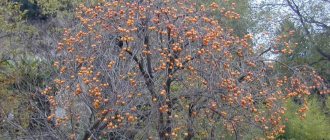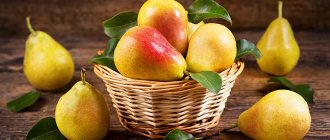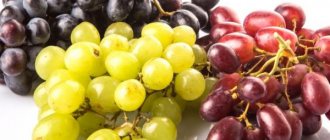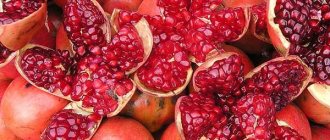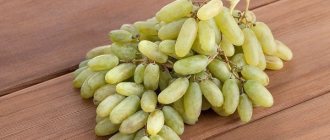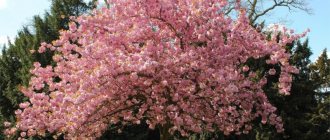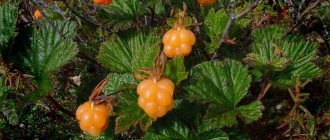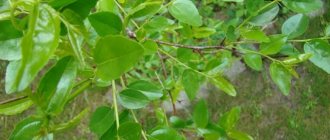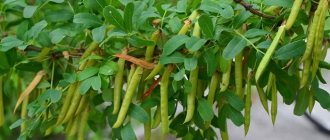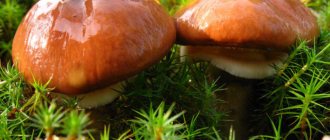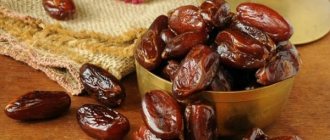Description of bird cherry and its photo
As you know, among animals the wolf is considered the orderly of the forest, but among plants, bird cherry occupies this place of honor. Certain parts of the tree are used with great success in folk medicine.
The berries and foliage of the plant have a fairly strong aroma, which is endowed with phytoncidal qualities. It helps destroy various harmful insects and microorganisms that cause diseases.
Bird cherry can be classified as both trees and large shrubs. Its average height is about 7 meters. But there are trees reaching 17 - 18 meters. The trunk of the plant is often curved and has the shape of an arc directed towards the ground. The trunk diameter is not large and reaches a maximum of half a meter. The stem bark is dark brown, slightly cracked, and has red and burgundy spots.
The color of bird cherry foliage depends on its age.
Young ones have a lighter, fresher green hue, while old ones have a faded green hue. The shape resembles an egg, only slightly larger, from 5 to 25 cm in length, with a width of at least 6 cm.
The beginning of flowering of the plant can be observed towards the end of May. Depending on the variety, the color of the flowers can range from pure white to pink or even red.
Wood with its diffuse-vascular structure is quite often used to produce handicrafts necessary for everyday life. Things of this kind are in demand and have a certain value, since the wood from which they are made is famous for its special viscosity and elasticity.
Of particular interest to humans are the fruits of the plant, the ripening of which occurs around the end of August - mid-September. Collected, properly dried, and then crushed fruits are used in the process of baking pies or pies, and are also added to yeast dough for baking baked goods.
Berries are also an indispensable component when cooking jelly and compotes. They make excellent homemade tinctures, wines, and liqueurs. Also, their use is often mentioned in traditional medicine recipes.
Bird cherry fruits are round in shape and have a fleshy structure. In color, they are mostly black, but depending on the variety they can be red. Their diameter is approximately 1 cm. The taste of the fruits is quite sweet and astringent, but they have a slightly noticeable bitter tint.
The benefits and harms of bird cherry for the body
Useful properties of bird cherry The pulp contains vitamins, fruit acids, and numerous minerals. Kharkov scientists in 2015 discovered hydroxycinnamic acid, anthocyanins, and flavonols in drupes. Rutin and quercetin dominate among them. They lower cholesterol levels, reduce inflammation, suppress the growth of tumor cells, and are good for vision.
Rutin stimulates bone formation, improves endothelial function, and counteracts the development of diabetes and neurodegenerative diseases caused by prions.
Use of drupes in medicine People have long been familiar with the plant. This is proven by finds from the Stone and Bronze Ages in the Alps. The Dutch botanist Rembert Doduns, who lived in the 16th century, recommended using the seeds as a diuretic and for the treatment of cholelithiasis.
Bird cherry is credited with antipyretic, anti-inflammatory, mild analgesic and restorative properties. It strengthens the heart and stomach. In Russia and Belarus, bird cherry is a popular remedy for combating diarrhea. To quickly stop it, residents of Mogilev eat a handful of dried berries. In Ukraine, for this purpose, they drink a decoction prepared from them.
In folk medicine, bird cherry has long been used for syphilis and gout, to relieve complaints from rheumatism, as an anesthetic and disinfectant. In homeopathy, the plant is used for abdominal pain, headaches, feelings of weakness, disturbances in the functioning of the stomach and heart.
The benefits of other parts of the plant The botanist Remy Villeme draws attention to the benefits of the bark in his work for 1799. An infusion was mainly made from it. According to the German pharmacist Adolf Duflas (19th century), it should be collected in March, and the leaves should be collected before and after flowering.
Tea made from the bark helps relieve eczema and other skin diseases that are accompanied by itching. The decoction is effective for swelling and non-healing wounds. Antidiarrheal agents are made from the leaves, and wound-healing, anti-inflammatory, and antibacterial agents are made from the flowers.
Harmful properties of bird cherry
- The fruits should be consumed after removing the seeds. Some people experience hypersensitivity to substances contained in bird cherry.
- Due to the presence of toxic compounds (mainly cyanogenic glycoside), there is no consensus regarding the safety of treatment with products from flowers, leaves, and bark. Healers advise using them with caution and for short periods of time. In large doses they cause headaches, dizziness, vomiting, and diarrhea.
- Bird cherry flowers and foliage emit a large amount of volatile phytoncides that purify the air and repel harmful microorganisms and insects. However, you should not stay near trees for a long time, inhaling their intense aroma, or bring large bouquets of flowering branches home, since volatile substances in high concentrations are dangerous for people and animals.
Types and popular varieties of bird cherry
There are approximately 20 species of bird cherry in nature. However, in our territorial zone there are only four.
The most common of them is common bird cherry, which is also called carpal or bird cherry.
It gained such popularity due to its high degree of frost resistance, ease of care, rapid growth and rich harvest.
Thanks to breeders, the Tenderness variety appeared, which is in special demand among almost all gardeners due to the special taste of the fruit. A distinctive feature of the plant is its relatively small, bright red flowers, which bloom in fairly large clusters.
The height of Tenderness hardly reaches 4 meters. The crown diameter is about 4 meters. The crown has the shape of a pyramid. The branches are located unusually, for this type of plant, densely. The aroma that appears during flowering is surprisingly pleasant.
Tenderness fruits are medium in size, but very sweet. Representatives of this variety require well-moistened soil. It is advisable to plant them in shaded areas.
Ideal for decorating your backyard. Quite often used to create landscape design.
In addition to varieties planted to obtain an edible crop, breeders have developed decorative varieties that are usually used exclusively for decorating a personal plot.
Pruning bird cherry in spring and autumn
Another aspect of plant care is periodic pruning.
For bird cherry it can be formative and rejuvenating (or sanitary):
- The first is performed with the aim of forming the crown of the plant in spring or autumn. It should begin immediately after planting the seedling in the ground. As stated above, the tree is pruned to a height of 50-70 cm. This will facilitate the establishment of skeletal branches of the first tier - it is necessary to leave no more than 4 well-developed side shoots, located at an even distance from each other. After a year, the plant will need to be trimmed at a height of 50 to 70 cm from the level of the first tier of the main branches to allow the second to form. According to this principle, the tree is pruned in the third year after planting to form the third tier.
- The second type of bird cherry pruning is performed in the fall for mature plants every year. At the crown, remove those branches that are dry, diseased or broken. Garden varnish is applied to the cut areas.
Bird cherry tree - planting and care
Growing ordinary bird cherry on your own plot is not at all difficult. It is enough to familiarize yourself with some rules of planting and growing.
Planting of this variety must be organized in a place with sufficient sunlight and space in which the plant could develop unhindered.
To obtain a rich and tasty harvest, experienced gardeners advise planting several different varieties of this crop. Their flowering should occur at approximately the same period. This will ensure cross-pollination for the seedlings.
It is also worth noting that when planting several seedlings, the distance between them must be at least 5 meters.
It will be better if the soil for planting has a neutral or slightly acidic pH. Soil moisture should be moderate.
The size of the planting hole should not be much larger than the size of the rhizome itself. Regarding the application of fertilizers of mineral and organic origin, there should be a minimum of them. When applying more fertilizers, the condition of the stem bark can deteriorate sharply.
Planting and care naturally imply timely, high-quality and proper watering. When planting, the seedling is well watered. Further watering should occur during the growing season, no more than three times during the entire period. The amount of watering can be increased only in case of drought.
Related article: Spring pruning of fruit trees
Mulching
The tree trunk circle must be covered with peat or sawdust mulch.
Planting is done either in spring or autumn. Bird cherry does not need special care. But, do not forget about timely seasonal weeding of the soil around the seedling.
This sanitary measure is mainly aimed at removing periodically appearing weeds. At the same time, weeding will help loosen the soil and thereby ensure access of oxygen to it.
All gardeners know that the earth tends to periodically become depleted. Therefore, it is necessary to timely feed the latter. Fertilizers of organic and mineral origin can be added both during digging and during watering.
For fertilizing, you can use ready-made mixtures specially designed for these purposes. It is better to purchase fertilizer for fruit and berry plants in a specialized store.
Removing rhizome suckers
When growing, do not forget about the fight against thickening. This procedure is carried out in the summer. It consists of removing the emerging shoots of the rhizome from time to time. The number of prunings will depend entirely on the growth rate of the shoots.
Periodic pruning will also be required. The first is done immediately after planting in the ground to form the correct crown. In the first year of pruning, the lower, that is, the first tier of the plant will be formed. Over the next years, by trimming skeletal branches, the entire crown will be formed.
Every year with the onset of autumn it is necessary to carry out sanitary pruning. This procedure is aimed at removing branches with the presence of various pathogenic formations, dried out for some reason or broken.
Planting bird cherry in open ground
When to plant
Bird cherry seedlings take root better when planted in spring and autumn. The plant prefers spacious, well-lit areas with rich, moist soil of neutral or slightly acidic reaction. In a shady place, the plant will reach towards the light, and the fruits will form on the tops of the branches and will be difficult to reach. As for the composition of the soil, bird cherry grows well in both sandy and clay soil, but it develops best in loam. It is desirable that the groundwater in the area lies close to the surface.
To achieve cross-pollination, trees of different varieties are planted on the site, but they bloom at approximately the same time. The distance between trees should be at least 5 m, since bird cherry grows quickly and its branches can reach several meters in length.
- Remontant strawberries: cultivation, diseases, varieties
How to plant
Bird cherry seedlings take root well in a new place, you don’t even need to prepare a fertile mixture for them - just dig a planting hole of such a size that the entire root system of the seedling fits into it, and put a layer of dry leaves, humus or peat mixed with mineral fertilizers on its bottom . Do not put a lot of organic matter, because its excess negatively affects the condition of the bird cherry bark. Before planting, carefully inspect the roots of the seedlings, shorten any that are too long and remove any diseased ones. Leave 2-3 strong shoots on the seedling, shorten them to 50-70 cm, and trim the rest.
Place the root system of the seedling in the hole and fill the voids with soil, then lightly compact the surface and water the seedling generously, and when the water is absorbed, mulch the tree trunk circle with peat or sawdust.
How to propagate bird cherry
Bird cherry is a plant that reproduces without any problems. Therefore, gardeners, if desired, can obtain young seedlings for sale or to increase the number of plants on their site. Reproduction can be done in several ways.
It is produced exclusively in the spring by separating shoots and planting the separated material in their new place of growth.
After the shoots have completely finished growing, they are cut off. The resulting cuttings should not exceed 15 cm in length. The foliage on them is torn off, leaving only the top couple. Then they are placed in water for a day. After the time has passed, they are ready for planting. Planting is done in nutrient soil under a film.
This method is applicable only in spring. The shoots that have grown from the root are dropped into previously prepared and correctly located holes. Until the end of spring and all summer, the shoots are weeded and periodically fertilized. In the fall, they can already be cut off from the root.
Those shoots whose root system turned out to be stronger and more developed are ready for transplantation to a permanent place of growth.
You can grow ordinary bird cherry using seeds. But it’s worth noting right away that this option will take a lot of time. This is the only reason why it is considered the most troublesome.
Caring for bird cherry in the garden
Growing conditions
Bird cherry is not a capricious plant, and it is easy to care for. At first, the seedlings need to be watered frequently, after which the soil around the tree trunk needs to be loosened and weeds removed (if you have mulched the soil around the seedling, you will not have to do this often). Older bird cherry trees need sanitary and formative pruning, fertilizing and protection from pests and diseases. Adult plants are watered several times during the summer, but in dry weather the bird cherry is watered more often. If the summer has precipitation, then it is quite possible that the bird cherry will have enough of it.
Trimming
Every year, the bird cherry is freed from diseased, dry, broken and thickening branches and shoots, and the cut areas are lubricated with garden varnish.
Bird cherry is formed both on a high trunk, in the form of a tree, and in the form of a multi-stemmed shrub. To form a cup-shaped crown of the tree, only the central shoot 50-70 cm high is left on the seedling, and the rest are cut out. After new shoots grow from the trunk, the first tier of 3-4 most developed and evenly spaced branches is laid. The angle of departure of the skeletal branches from the conductor (central shoot) is 50-70 º. The remaining shoots are cut into a ring.
The second tier is laid in the same way from 2-4 branches, 45-50 cm away from the branches of the first tier. In subsequent years, another 1-2 tiers are laid from 2-3 branches each. Subsequently, when the formation of the crown is completed, you just need to not let it thicken. It is also necessary to limit the height of the tree, not allowing it to outgrow the 3.5-4 m mark. This means that it is necessary to carry out sanitary and thinning pruning, remove root shoots, and also shorten the longest branches to a downward lateral branch in order to restrain the growth of bird cherry .
Transfer
It is better to transplant bird cherry trees in the spring, but preparations for the procedure are carried out in the fall. You need to dig a hole of such a size that the root system of the tree along with the earthen ball can fit in it.
When the air temperature drops to 5 ºC or slightly lower in the fall, but before the soil freezes, dig up the tree along the border of the trunk circle and water it generously so that the plant will retire with its roots in a frozen clod of soil. In the spring, try to prevent the earthen clod from thawing quickly. To do this, cover the soil in the tree trunk circle with snow, and lay burlap on top of it and cover it with sawdust. When the snow does melt, dig up the bird cherry tree without allowing the ground to thaw, pull it out, tie the earthen ball with burlap so that it does not collapse during transportation, moisten the burlap generously with water, then, laying the tree horizontally, carefully move it with its roots forward to a new place and plant without removing the burlap from the roots. The fabric will not interfere with the growth of roots in a new place.
After transplanting, the bird cherry is supported in an upright position with wire braces attached at one end to the trunk and the other to deeply driven stakes. To prevent the wire from damaging the bark, birch bark, rags or cardboard are placed under it. To successfully restore the root system, the bird cherry needs to be protected from the sun at first. Water the transplanted bird cherry with root former solutions. When the bird cherry tree takes root in a new place, they care for it as usual, but only for the winter the trunk is buried high in earth, and covered with humus or manure on top of the ground, protecting the roots from freezing.
Bird cherry propagation
Bird cherry propagates by root shoots, cuttings and grafting. You can also grow bird cherry from seeds by sowing them in August or September, but seedlings do not always inherit the characteristics of the mother plant.
The most popular and easiest way to propagate bird cherry is cuttings. In autumn, cuttings 18-20 cm long are cut from young branches, which are stored in a cool place in winter, wrapped in cloth or paper. In the spring, two weeks before planting the cuttings in the ground, they are treated with a solution of potassium permanganate for disinfection, and then placed in water to grow roots. After the roots appear, the cuttings are planted in loose and moist soil. Caring for cuttings consists of watering and carefully loosening the soil around them. When the seedlings have developed a root system, they can be planted in a permanent place, but you should know that they are difficult to tolerate transplantation, so it is better to immediately root them in a permanent place.
To propagate bird cherry by layering, select a low-growing branch on the bush, make an incision on it, bend it to the ground and place it in a 30 cm deep trench dug two days earlier with peat placed in it. The branch is fixed in this position, leaving the top on the surface. By autumn, the cuttings can be separated and planted in a new place. The survival rate of bird cherry layerings is quite high.
It is not difficult to propagate bird cherry trees using grafting, since scions take root on the rootstock with a 95% probability. The procedure is carried out in mid-summer. Cuttings from young shoots are chosen as a scion.
- Yarrow: properties, planting and care, types and varieties
Pests and diseases
Bird cherry is affected by diseases such as leaf spots (rubella, coniothyriosis, cercospora blight), powdery mildew, cytosporosis, wood rot, pockets of flowers and fruits, and among pests it is annoyed by aphids, herbivorous bugs, leafminer moths, gypsy moths, hawthorn, and ermine bird cherry moths. and weevils.
Cytosporosis affects the trunk and branches of bird cherry, causing them to dry out. The disease manifests itself by the formation of small white tubercles on the plant trunk - pycnidia of the fungus. And in humid weather, reddish threads stand out from them. When the first symptoms appear, the affected shoots should be removed and burned along with fallen fruits and leaves. Trees in the spring, before the leaves appear, are treated with copper oxychloride or one percent Bordeaux mixture. In March, trunks and large branches are washed with iron sulfate, and in the fall the trunks are whitened with lime.
Wood rot is caused by tinder fungi. Infection occurs through wounds in the tree bark. During the process of wood decay, its structure, chemical and physical properties change. Unfortunately, if the process has gone far, the tree can no longer be saved, but if you find the place where the fungus has penetrated, immediately clean it up to healthy wood and cover it with clay mixed with a fungicidal preparation, then it is quite possible that the tree will be able to recover.
Pockets of flowers and fruits are the most harmful disease of bird cherry, caused by a fungus. As a result of the development of the disease, the bird cherry fruits are deformed, seeds are not formed in them, and the outside is covered with a coating consisting of bags of the causative fungus. Affected flowers usually die without setting fruit, and the plant is depressed. Diseased flowers and fruits should be removed. Before flowering, bird cherry is treated with a three percent solution of iron sulfate, a one percent solution of copper sulfate or Bordeaux mixture.
Powdery mildew is manifested by the formation of a white cobwebby coating on the leaves and shoots of bird cherry, which over time becomes unnoticeable, but the dark fruiting bodies of the fungus can be seen on it. In the spring the disease resumes. You can read about how to get rid of powdery mildew in our article posted on the website.
Rubella, or polystigmosis, or red leaf spot, is a disease of a fungal nature. Bright red spots appear on the leaves of the bird cherry tree, clearly visible against the green background. To destroy the infection, trees and the soil under them before buds open are generously treated with a three percent solution of Nitrophen or copper sulfate, and after flowering they are sprayed with a one percent Bordeaux mixture. In case of severe damage, a third treatment with a fungicide is carried out 2-3 weeks after flowering.
Cercospora blight is a disease whose signs are very small necroses of irregular shape: they are whitish on the upper side of the leaf and brown on the lower side. Gradually the spots merge, the affected tissue falls out. The drug Topaz, used in accordance with the instructions, works well against the causative agent of infection.
Coniothyriosis affects the leaves, bark of branches and fruits of bird cherry. On diseased organs, single or merging irregularly rounded yellow or brown necrosis appears, surrounded by a dark orange border. Black dots of pycnidia appear in the center of necrosis. Destroy the causative agent of infection with fungicidal drugs.
As for pests, bird cherry trees are treated against them twice per season: in early spring, as soon as the leaves bloom, and after flowering. For treatment, use a solution of 60 g of Karbofos in 10 liters of water. About 2 liters of the drug are used for each tree.
Tree diseases and pests
This type of fruit and berry plants has a fairly high immunity to diseases of various kinds, including pests. But, it will not be superfluous to familiarize yourself with those that can appear and harm both the tree itself and its fruits.
Powdery mildew
This disease of fungal origin is known to all gardeners. It is expressed in the formation of a whitish color on the surface of the leaves. The most correct way to combat it is to collect and destroy all fallen and damaged leaves.
It would not be superfluous to spray the diseased tree with Bordeaux mixture. Spraying must be done several times.
Red spot
It appears exclusively on the leaves, as red spots of various shapes and sizes. Without timely elimination, it can lead to the early fall of all leaves, which will have a very detrimental effect on the condition of the entire tree as a whole.
Treatment is carried out by analogy with the fight against powdery mildew.
Regarding pests that interfere with the active growth and fruiting of a tree, these are mainly insects that feed on tree sap, actively eat the foliage, a large variety of mites and bark beetles.
To exterminate them, you will need to treat them with karbofos, which must be done at least twice. In cases where insect damage to a tree is quite severe, treatment can be carried out more times.
It is better to treat young seedlings both as treatment and as prevention with tobacco infusion or soap solution.
Bird cherry diseases
Ella Sokolva, Candidate of Biological Sciences
Diseases of fungal origin predominate on both wild and ornamental bird cherry species growing in Russia. The degree of harm they cause depends both on the biological characteristics of the pathogens and the affected bird cherry species, and on environmental conditions.
Fruit grower diseases
Deformation of fruits (pockets). The causative agent is the fungus Taphrina pruni. In affected fruits, increased growth of the fleshy part - the ovary - occurs and the development of the stone is suppressed. As a result, diseased fruits take on the appearance of ugly brown sac-like structures, hollow inside - pockets. The massive development of the disease leads to a decrease in yield, and in urban plantings - to a loss of decorativeness of trees.
To protect against the disease, it is recommended to collect and destroy fallen diseased fruits, and in the spring, before the buds open, to spray the trees with copper-containing preparations.
Leaf diseases
Leaf rust . The causative agent is the fungus Thecopsora padi (= Th. areolata). It alternately develops on cones of spruce and bird cherry. Bird cherry leaves become infected from diseased spruce cones. In summer, small, angular, red-purple spots form on the undersides of the leaves. Later, dark reddish-brown spots appear on the upper side.
The disease occurs in forests and forest parks.
Hole spot (clusterosporiosis) of leaves . The causative agent is the fungus Clasterosporium carpophilum (= Stigmina carpophila). At the beginning of summer, rounded light brown spots with a red-brown or crimson border, 2–5 mm in diameter, form on the leaves. With severe development of the disease, numerous spots along the edges of the leaves and near the main vein merge. After the spots fall out, round holes remain in their place, as a result of which the affected leaves look as if they had been eaten by leaf-eating insects.
Brown leaf spot . The causative agent is the fungus Gloeosporium padi. In the second half of summer, large rounded brown or brown-green spots appear on the leaves. On the upper side of the spots, sporulation of the fungus forms in the form of numerous small yellowish-brown pads. With severe development of the disease, the spots merge, covering almost the entire surface of the leaves.
Orange leaf spot . The causative agent is the fungus Polystigma ochraceum. In the second half of summer, round or angular spots with a diameter of up to 10 mm, flat or slightly convex, appear on the leaves of common bird cherry. At first they are bright orange, later they acquire a red-brown color. Often numerous spots merge, covering most of the leaf surface. The disease is widespread in Siberia and the Far East.
Purple leaf spot . The causative agent is the fungus Asteroma padi. Common bird cherry is affected. In the second half of summer, large round grayish-violet or brown-violet spots with a diameter of up to 15 mm, with blurry edges, often covering almost the entire surface of the leaves, form on the leaves.
Spotting leads to a decrease in the decorative value of trees and premature leaf fall. To protect against spotting, it is necessary to rake and destroy fallen leaves. In case of systematic damage, the crowns are sprayed with Bordeaux mixture or Fundazol in the summer.
Monilial burn (moniliosis). The causative agent is the fungus Monilia laxa. Flowers, leaves, shoots, and fruits are affected. In the spring, the flowers turn brown and dry up, and later the leaves and young shoots, which often remain hanging on the tree until the next spring. Sick trees look like they have been damaged by frost or fire. The disease develops most actively in conditions of high humidity.
To protect against moniliosis, it is necessary to prune dried shoots and branches, and in the spring, before and after flowering, spray the crowns with Bordeaux mixture.
Diseases of trunks and branches
Cytospor necrosis (cytosporosis) of trunks and branches. The causative agent is fungi from the genus Cytospora. The affected bark of trunks and branches dies around their circumference or in individual areas. In the dead bark, sporulation of pathogens is formed, which look like numerous small conical tubercles, completely covering the affected areas. Fungal spores emerging on the surface of the bark look like reddish or bright red drops or flagella.
Cytosporosis affects trees against the background of preliminary weakening, accelerates it and often leads to the death of plants.
Limiting the spread of cytosporosis is facilitated by the creation of optimal conditions for the growth and development of plants, timely pruning of affected and withered branches, which are a source of infection.
Gum therapy . The disease manifests itself in the release of a sticky amber-yellow or brown liquid – gum – on various plant organs. The release of gum is accompanied by some infectious diseases of bird cherry: clasterosporiasis, moniliosis, cytosporosis, as well as mechanical damage, frost-sunburn, etc. Gum discharge contributes to the death of shoots and branches.
The fight against gum deposition includes: prevention of mechanical damage; carrying out a set of measures to protect against pests and diseases; creating optimal conditions for plant growth and development. Brown rot of roots. The causative agent is the Schweinitz tinder fungus (Phaeolus schweinitzii). Rot develops in the central part of the roots and trunks. At the base of the trunks, large funnel-shaped yellow-brown, velvety fruiting bodies of the fungus are formed. Old bird cherry trees in forest and parkland plantings are affected. Sick trees fall out with the wind, and in more rare cases, dry out.
Rot of bird cherry trunks is caused by various wood-destroying fungi, the most common of which are: plum polypore (Phellinus tuberculosus), sulfur-yellow polypore (Laetiporus sulphureus), false polypore (Phellinus igniarius), chondrostereum purpureum.
Stem rot contributes to brown wood, which poses a great danger in urban plantings and on private property. Therefore, trees showing signs of rot must be taken under control and, if there is a real threat, they must be removed.
Deformation of fruits (pockets) Orange spotting of leaves Fruiting bodies of sulfur-yellow tinder fungus
Benefits of bird cherry fruit
Modern medicine recognizes fully ripened berries as raw materials for the creation of medicines aimed at treating various disorders of the gastrointestinal tract.
The main value of the berries is the tannins they contain and the cyanogenic glycoside amygdalin, which in a certain concentration actively fights tumors.
Traditional medicine also actively uses the fruits to treat the stomach and eliminate diarrhea. But, besides this, you can find recipes for combating other diseases using not only berries, but also other parts of the common bird cherry that are no less useful for the human body.
You can learn more about bird cherry and its beneficial properties by viewing the following:
Bird cherry Maak
In its natural environment it grows in the southern regions of the Far East, China and Korea. The tree grows up to 17 meters in height, sometimes growing as a shrub, up to 4-8 meters high. The bark is cone-shaped, the bark is smooth, reddish-orange in color, and may peel off over time. Bird cherry leaves are rich green in color and turn yellow in the fall. Blooms from mid-May to early summer. The fruits have no nutritional quality. The flowers are white and have no scent. The tree is fast growing, resistant to low temperatures, needs good lighting and high humidity.
Bird cherry
Bird cherry Padus racemosa Gilib. (Prunus padus L.)
The generic name is from the Latinized Greek name of the tree, possibly Magaleb cherry - Pados; or from the Latin name of the Po River in Italy; racemosus - racemose.
Bird cherry is a real “green pharmacy”. All its parts - leaves, flowers, fruits and bark - are medicinal to a certain extent.
A branch of bird cherry with leaves, lowered for a few minutes into a mug of water of dubious quality, quickly kills bacteria in it. You can drink this water without fear. In addition, it becomes fragrant and pleasant to the taste.
Transplanting bird cherry in the spring and preparing the site in the fall
Another important issue that requires attention is replanting a bird cherry tree or bush from one place on the site to another. This procedure is recommended to be carried out in early spring, but preparations for it should begin in late autumn.
First you need to dig a hole of the required size and leave it until spring so that the soil settles.
When the thermometer drops to +5? C, and this air temperature has stabilized, it is necessary to dig around the trunk of the plant, which is planned to be replanted in the spring, and water it abundantly so that the rhizome goes into a state of winter dormancy in the frozen soil.
When spring arrives, care must be taken to ensure that the lump of soil does not thaw too quickly. To do this, cover the soil with the snow that still remains, and lay burlap and sawdust on top.
Bird cherry trees prepared in the fall are replanted when the snow has completely melted. The plant is dug up so as not to touch the rhizome and moved with a lump of earth into a hole for planting. To prevent the soil from crumbling, it is better to sprinkle the roots with water and tie them with burlap. You don’t even need to remove it when planting - it will not become an obstacle to the growth of the root system, and at the right moment it will disintegrate itself.
Next, you need to secure the transplanted plant with wire ties to the stakes placed nearby. To prevent the metal from touching the trunk, a lining is made of cardboard, fabric, or birch bark.
To prevent the transplanted tree or bush from dying, it is necessary to create shade for it; the plants should be watered with the addition of a root development stimulator.
Description of the plant
Bird cherry is a tree or large shrub of the Rosaceae family, from 2 to 10 m in height. The bark is matte, black-gray, on young branches; cherry-brown with whitish-yellow lentils; The inner layer of the bark is yellow with a characteristic almond odor. The leaves are alternate, oblong-elliptic, thin, short-petioled, sharp, glabrous, 6-12 cm long and 2-6 cm wide. The flowers are white, fragrant, on peduncles, collected in dense drooping racemes 8-12 cm long. The fruits are spherical black. drupes with a diameter of 8-10 mm, sweet, astringent. Blooms from April to June; Depending on the location and weather conditions, the fruits ripen in July - September.
Related article: Oil tree description and features
The medicinal raw materials are ripe bird cherry fruits.
Features of bird cherry
Bird cherry is a shrub or a not very large tree; its height varies from 0.6 to 10 meters. The crown is lush and elongated. The matte black-gray bark has white lentils. The color of young stems and branches is olive or cherry. Alternately arranged simple bare leaf plates have an oblong or elliptical shape with a pointed apex and a sharp-serrated edge. Their length is 3–15 centimeters. The leaves are located on thin petioles; there are 2 glands at the base of the plate. The length of the racemose drooping inflorescences is from 8 to 12 centimeters; they consist of fragrant flowers, painted pale pink or white. The composition of the flower includes: 5 petals and sepals, a pistil, 20 stamens and yellow anthers. The fruit is a black spherical drupe, which reaches from 0.8 to 1 cm in diameter. The fruits have a sweet, strongly astringent taste, and inside them there is an ovoid-rounded stone. This plant blooms in May and June, and fruit ripening is observed in July and August.
Bird cherry
Habitats
Bird cherry grows mainly in the forest zone, along river valleys it penetrates into the forest-steppe and steppe zones, in the north it reaches the northern border of the forest-tundra; in the mountains it is found up to an altitude of 1500-1800 m above sea level.
Prefers moist, fertile and drained soils with close groundwater. Optimal habitats are floodplains in flat areas; in mountainous regions—the bottoms of the valleys of the largest rivers in the low-mountain zone. The densest populations of bird cherry are found in mixed thickets of bushes. Under the canopy of forests and woodlands, bird cherry forms less dense clump thickets, usually characterized by a small number of fruiting shoots and yield.
Bird cherry blossoms well almost every year, but does not bear fruit every year, since its flowers are damaged by late spring frosts, and the trees themselves are attacked by numerous pests, especially near cities and large towns. In the floodplains of large rivers, due to the later development of vegetation due to floodplain habitat conditions, it suffers less from spring frosts.
Red-leaved bird cherry varieties
There are not many varieties of red bird cherry, but all are beautiful and undemanding to care for. They are distinguished by high winter hardiness, resistance of the root system to close groundwater, sunburn, and allow the formation of the crown in the outlines conceived by gardeners. Almost all varieties of Virginia bird cherry (“Shubert”, “Purple Queen”, “Canada Red”, “Summer Glow”), as well as the common bird cherry “Colorata”, are classified as red-leaved. See descriptions of these varieties above.
Procurement and quality of raw materials
Bird cherry fruits are harvested during their full ripeness (from late July to September) in dry, clear weather. The collected fruits are placed in baskets and no later than 3-4 hours after collection they are delivered to the drying site.
When collecting bird cherry fruits, you should not cut its axial shoots, and during flowering, you should not break its branches. To rejuvenate bird cherry thickets and, consequently, increase their productivity in dense thickets, it is advisable to carry out thinning. When carrying out reclamation work in river floodplains, highly productive thickets of bird cherry should be left.
Bird cherry has been cultivated everywhere and is grown in gardens and parks. It feels good in culture, is unpretentious, and does not require intensive care. To combat insects, biological and mechanical methods are recommended, as well as a high level of agricultural technology.
The collected clusters with bird cherry fruits are dried in ovens or dryers at a temperature of 40-50 ° C, spread in a thin layer (1-2 cm) on metal baking sheets or on racks. You can dry bird cherry fruits in the sun or in attics with good ventilation. Then the brushes are ground and the fruits are separated on sieves from the stalks and twigs. The yield of dry raw materials is 42–45%. Raw materials are packaged in bags with a net weight of no more than 50 kg and transported, protecting them from dampness. Store in a dry, well-ventilated area, on racks. The shelf life of raw materials is 3-5 years.
Bird cherry raw materials consist of spherical or oblong-ovoid drupes with a diameter of up to 8 mm, wrinkled, without stalks, with seeds with a diameter of up to 7 mm. There is no smell, the taste is sweetish, slightly astringent. Humidity is not higher than 14%. No more than 3% of burnt or insect-damaged fruits are allowed in raw materials; 4% unripe fruits; 2% other parts of bird cherry; 1% organic impurity; 0.5% mineral.
The genus and its representatives
Olga Nikitina
The genus Bird Cherry (Padus) belongs to the large Rosaceae family and has 20 species, which mainly grow in East Asia and North America. The genus includes deciduous trees, less often shrubs with simple serrated leaves. The flowers are white, fragrant, collected in racemes, the fruit is a juicy drupe.
Bird cherry trees usually grow on fertile soils with excess flowing moisture or in the mountains - on rocky slopes and screes. In forests they can be found on the edges or among bushes.
The wood of representatives of this genus is diffusely porous, with a reddish-brown core, dense, and in some species with a pleasant odor. Used for small crafts such as smoking pipes, as well as for making bent furniture and turning products.
In culture, bird cherry trees have long been used as trees that bloom profusely in spring, which at this time can outshine many other tree and shrub species in their appearance. They are planted in both pure and mixed groups. As for bird cherry fruits, in most species they are attractive only to birds, although some garden centers now offer large-fruited varieties that are palatable.
Bird cherry is an unpretentious tree species. It is undemanding to soil and watering, and can grow both in well-lit places and in partial shade. But, of course, it develops better in nutritious, moderately moist soils and in good light. Mature plants provide a lot of shade, and this must be taken into account when building compositions using bird cherry trees.
Bird cherry leaf litter helps improve litter, as its leaves are rich in lime, potassium and nitrogen. Caring for bird cherry is simple; it consists mainly of loosening the soil around the plant and removing weeds, as well as applying root and foliar fertilizers. If necessary, carry out sanitary and formative pruning.
Bird cherry leaf litter helps improve litter, as its leaves are rich in lime, potassium and nitrogen.
Among the species diversity of the genus in our country, the most common is the common blackberry (P. rasemosa), the range of which in the north reaches the forest-tundra, in the east - to the Yenisei River, in the south - to the forests of the Caucasus. This tree is up to 17 m high, with a broadly ovate crown, the trunk is covered with brown-black cracking bark. During flowering, Ch. vulgaris is covered with white fragrant racemes up to 12 cm long and turns into a fairy-tale beauty. The black drupes that ripen towards the end of summer are pecked with pleasure by birds, and in Siberia and the Urals local residents use them for food, grinding them into flour suitable for filling pies and jelly.
Among the decorative varieties of black cherry, the most interesting and original are considered to be 'Colorata' and 'Purple Queen', which have oval copper-purple leaves, especially bright when blooming, and pinkish inflorescences. The big disadvantage is the abundant root growth that has to be dealt with. But groups and single plantings involving these bird cherry trees turn out to be very attractive. There are also a number of beautifully flowering varieties: 'Plena' - with large double flowers; 'Watereri' – with multi-flowered inflorescences up to 20 cm long; 'Alberti' – with an unusual vertical crown.
Maak's bird cherry (P. maackii) is a tree up to 15 m high, with a spreading, loose crown, growing in the Ussuri taiga. It is distinguished by exfoliating bronze bark, reminiscent of birch. The leaves are elliptical, up to 10 cm long, on long petioles, finely serrated along the edges. In autumn they turn yellow. Flower brushes are denser than the previous type. Bird cherry Poppy is a very winter-hardy and fast-growing tree species. These properties of I.V. Michurin used it in breeding high-yielding, cold-resistant sweet varieties of cherries. Bird cherry Poppy is indispensable for landscape parks and urban landscaping. She is especially good in bouquet plantings, which can be admired in the Biryulevsky Arboretum in Moscow.
Bird cherry (P. serrulata) is a tree up to 25 m high, with an ovoid crown, growing in the Primorsky Territory and Sakhalin. The trunk is covered with smooth brownish-gray bark. The leaves are elliptical, with a strongly retracted tip, bronze in color when blooming, light green and orange in summer, violet-brown in autumn. Flowers up to 3 cm in diameter, white or pink, collected in few-flowered racemes of 2–4 pieces. It is considered one of the most beautifully flowering bird cherry trees, but is less frost-resistant than previous species.
Bird cherry (P. ssiori) is a short tree with dark gray bark that grows on Sakhalin and the Kuril Islands. The leaves are elliptical or ovate, up to 14 cm long. White, small flowers are collected in multi-flowered narrow cone-shaped racemes up to 15 cm long. It is considered a very frost-resistant species.
Bird cherry mahalebka , or antipka (P. mahaleb), is a low bush-like tree with a spherical crown. The bark is dark brown, smelling of coumarin. Grows in the Tien Shan, Pamir-Alai, eastern Transcaucasia, Crimea. One of the most drought-resistant species. From the leaves and fruits, fragrant water is obtained by distillation, used in perfumery. Unlike many other types of bird cherry, it does not produce root suckers and tolerates shearing well, so it is used to create tall hedges, including clipped ones.
North American species, such as late ch. , Virginian ch. , Pennsylvanian ch. .
Late bird cherry (P. serotina) is a fast-growing tree up to 30 m high, with dark brown, finely fissured, aromatic bark. It is very decorative because of its shiny dark green foliage, which turns an intense light yellow color in the fall. In the USA, pink-brown wood of this type is highly valued and is widely used in furniture production and finishing work.
Virgin bird cherry (P. virginiana) is a tree up to 15 m high with a broadly ovate crown. The trunk is covered with finely scaly black bark with an unpleasant odor. Its dark red drupes are not only beautiful, but also edible. Often used in green building, especially decorative deciduous varieties:
'Canada Red' is a shrub up to 5 m high. When blooming, the leaves are green, then become dark burgundy. Looks great during flowering, when white, racemose inflorescences appear on the branches;
'Schubert' is a shrub up to 3–4 m high. The leaves are glossy, red-violet, up to 10 cm long. The only drawback of these varieties is that they produce abundant root shoots.
Pennsylvania bird cherry (P. pensilvanica) is a tree up to 13 m high with a narrow ovate crown. The trunk is covered with dark brown aromatic bark. The white flowers are collected in very short racemes, more like an umbrella, so some taxonomists classify this species as belonging to the genus Cherry.
Pennsylvania bird cherry is quite suitable for solitary planting, in groups and trimmed hedges.
Bird cherry Common bird cherry Common bird cherry 'Colorata' Bird cherry
Chemical composition
The whole plant contains the glycoside amygdalin, which is enzymatically broken down into benzaldehyde, hydrocyanic acid and glucose. In addition, the fruits contain tannins, the glycoside prulaurazine, organic acids (malic, citric), anthocyanins, flavones, vitamin C, sugars (up to 5%). The leaves and bark also contain tannins and the glycoside prulaurazine; in the leaves - vitamin C (up to 200 mg%); in leaves, flowers, seeds - bitter almond oil. The main biologically active substances of bird cherry are tannins, which must be contained in the raw material at least 1.7%.
Bird cherry pests
Tamara Galasyeva, Candidate of Agricultural Sciences
Of the bird cherry pests, more than a hundred species of insects and herbivorous mites are known, damaging almost all vegetative and generative organs of the plant: buds, leaves, shoots, flowers, fruits and trunks. Most bird cherry pests are polyphagous, i.e. they also feed on other types of woody plants, especially those belonging to the Rosaceae family.
Sucking pests
Sucking insects and mites feed on sap from buds, leaves, shoots, branches and trunks.
These include several species of coccids (scale insects, false scale insects), mealybugs), aphids, psyllids and herbivorous bugs. Most of them can also be found on other species: apple scale, willow scale, hall scale, Ussuri scale insect, peach scale (false scale, grass-cherry aphid, etc. With mass reproduction of sucking pests, curvature of shoots, twisting, yellowing and drying of leaves are observed.
Leaf-eating insects
These insects damage buds, leaves, flowers and green shoots. Caterpillars of the gray pocket moth feed on bird cherry flowers. The shoots are eaten by the larvae of the bird cherry shoot weevil. Caterpillars of butterflies, larvae of sawflies and leaf beetles feed on the leaves. Several dozen species are known from the following families of butterflies: crested butterflies, bear moths, leaf rollers, waveflies, ermine moths, white butterflies and several species of sawflies, including true sawflies and sawfly weavers. The leaves are skeletonized by the larvae of the bird cherry leaf beetle.
In bird cherry thickets and on separately growing trees, outbreaks of mass reproduction of hawthorn and bird cherry moths sometimes occur. The caterpillars of these butterfly species live and feed in web nests, weaving together several leaves on a branch or shoots.
Miners and gall formers
Miners are insects whose larvae feed inside leaf tissue and form mines of various colors and shapes in the leaves. There are several known species of insect miners, the most common of which is the apple leaf miner, which forms long narrow mines on the leaves.
Galls on bird cherry leaves are created mainly by herbivorous mites. Galls in the form of small whitish or pinkish horns up to 4 mm high are formed by the bird cherry gall mite. Galls in the form of small white or brown felts on the lower, less often the upper side of the leaves belong to the bird cherry felt mite.
Stem pests
Pests of wood and bark of trunks and branches are classified as xylophagous insects, or stem pests. Several dozen species from the families of bark beetles (genus Scolytus, Anisandrus, Lymantor, Polygraphus) and longhorn beetles (genus Pogonocherus) are known on bird cherry trees. They all settle on drying and withered trunks and branches.
Pests of fruits and seeds
Pests of fruits and seeds are called carpophages. The pulp of the fruit is eaten by the larvae of the cherry fruit sawfly, and the contents of the seeds are eaten by the larvae of the stone beetle.
Bird cherry fruits are pecked by birds and eaten by many mammals - from chipmunks and squirrels to bears.
Crown of bird cherry tree damaged by bird cherry moth Spider nest of bird cherry moth with its caterpillars Hawthorn butterflies Galls of bird cherry gall mite Mines of apple tree leaf miner Galls of bird cherry felt mite
Use in cooking
Bird cherry is widely used in cooking. The berries are inferior in taste to their relatives - cherries, cherries and plums due to their slightly astringent taste and sourness, but they are healthy for the body and aromatic.
Dried berries are ground into flour . Used as an additive to bakery products. The baked goods acquire a delicate delicate aroma.
Use:
- a cake is baked from bird cherry flour;
- make delicious bird cherry kvass;
- tinctures and liqueurs are made on its basis;
- fresh berries are an excellent filling for pies;
- make jelly, fruit drinks, syrups;
- young leaves can be used for salads;
- make tea;
- making jam.
Bird cherry is especially valuable for northern regions , where berries that can be grown in temperate latitudes cannot ripen.
Bird cherry is widespread throughout our country. It pleases with its flowering and delicate aroma. Used in medicine and cooking . Gardeners are planting new varieties. Decorative tree species are used in landscape gardening. Poets and writers wrote about bird cherry with warmth and love.
Aftercare
After planting, the soil under the seedling is regularly moistened for a month. It’s bad if the water is near the trunk; the ground should be evenly and moderately moist. After a month, it is recommended to water the bird cherry only during drought. After watering, the soil must be mulched.
Several times a year it is necessary to loosen and dig up the soil under the tree. It is important to apply organic and mineral fertilizers at the root of the plant twice a year, before flowering and after the leaves fall.
Pruning is a mandatory procedure for caring for a bird cherry tree. Pruning is carried out in autumn and early spring. Remove old, dried, damaged shoots. In addition to hygienic pruning, they also carry out shaping. The crown of the bird cherry is formed in the form of a pyramid or ball.
In late autumn, the tree trunk should be protected from rodents. It is wrapped in roofing felt, cellophane, or any other covering material, and tied with a rope. Bird cherry does not need protection from frost; it should not be covered for the winter. If the temperature is lower - 20 ᵒC, you can throw more snow around the trunk and rhizome.
Bird cherry Poskistnaya
The tree feels good in middle and northern latitudes. This is a small tree, growing only up to 5 meters in height. Its trunk is gray with roughness, and its thin shoots are upright and brownish in color. The leaves are small in size, elongated oval in shape, greenish in color. The buds are snow-white, tightly pressed to each other, collected in inflorescences of 40 pieces. The tree blooms profusely, the fruits are flat and round, brownish in color. The pulp of the fruit is yellow and juicy, the taste is sour-sweet and tart. The tree is high-yielding, the berries ripen early. Bird cherry bears fruit consistently and is resistant to low temperatures and insect damage. The berries can be eaten fresh, dried or canned.
What's new among traditional bird cherry varieties?
Typically, among the cultivated varieties of garden bird cherry, three main types are distinguished:
- Common bird cherry - this species blooms quite luxuriantly and produces abundant harvests;
- Virgin - has a later flowering period and produces more stable berry yields;
- Late bird cherry differs from the previous ones in that the fruits ripen exactly one month later.
But years of work by breeders, conjuring the main types of bird cherry and cultivated varieties of cherries, have made it possible to develop the most popular varieties. Their main distinguishing features are resistance to various diseases and pests, as well as the absolute absence of a tart and astringent taste. In addition, they managed to significantly enlarge the fruits.
Bird cherry Antipka
This is a shrubby form of bird cherry with a powerful root system and lives up to two hundred years. The plant is unpretentious, adapts to different soils, and can grow even on a rocky slope. The species is native to the Middle East and Europe. The plant is very valuable because it can be used as a rootstock for cherry and plum trees. The shrub is most often grown to strengthen the slope. Bird cherry inflorescences are small, white, and have a pleasant aroma. The fruits are small and blackish in color.
